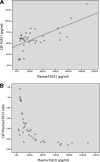Fibroblast growth factor 21 (FGF21) in human cerebrospinal fluid: relationship with plasma FGF21 and body adiposity
- PMID: 21926274
- PMCID: PMC3198100
- DOI: 10.2337/db11-0672
Fibroblast growth factor 21 (FGF21) in human cerebrospinal fluid: relationship with plasma FGF21 and body adiposity
Abstract
Objective: Reports of increased circulating fibroblast growth factor 21 (FGF21) levels in obesity indicate that FGF21 may be implicated in body weight homeostasis. We sought to investigate the existence of FGF21 in human cerebrospinal fluid (CSF) and, if present, the relationship between CSF FGF21 with body adiposity and metabolic parameters.
Research design and methods: CSF and corresponding plasma FGF21 were measured by an enzyme-linked immunosorbent assay (18 men and 20 women, aged 19-80 years, and BMI 16.2-38.1 kg/m(2)) and correlated to body adiposity and metabolic parameters.
Results: CSF and plasma FGF21 increased in particular with rising BMI and fat mass. In CSF, FGF21 was detectable at concentrations ~40% that of plasma levels. CSF and plasma FGF21 levels were significantly positively correlated with BMI and fat mass, body weight, plasma insulin, and homeostasis model assessment of insulin resistance. Plasma FGF21 levels were significantly negatively correlated with plasma adiponectin. When subjected to multiple regression analysis, only fat mass was predictive of plasma FGF21 (β = 0.758; P = 0.004) and CSF FGF21 (β = 0.767; P = 0.007). The CSF-to-plasma FGF21 ratio was significantly negatively correlated with BMI, fat mass, and plasma FGF21. Subjects in the highest plasma FGF21 quintile had a lower CSF-to-plasma FGF21 ratio (12.7% [9.7-14.9%]) compared with those in the lowest plasma FGF21 quintile (94.7% [37.3-99.8%]) (P < 0.01).
Conclusions: Our observations have important implications with respect to the potential central actions of FGF21. Future research should seek to clarify whether FGF21 would be beneficial in the management of obesity and its metabolic complications.
Figures


References
-
- Gospodarowicz D. Localisation of a fibroblast growth factor and its effect alone and with hydrocortisone on 3T3 cell growth. Nature 1974;249:123–127 - PubMed
-
- Inagaki T, Choi M, Moschetta A, et al. . Fibroblast growth factor 15 functions as an enterohepatic signal to regulate bile acid homeostasis. Cell Metab 2005;2:217–225 - PubMed
-
- ADHR Consortium. Autosomal dominant hypophosphataemic rickets is associated with mutations in FGF23. Nat Genet 2000;26:345–348 - PubMed
Publication types
MeSH terms
Substances
LinkOut - more resources
Full Text Sources
Miscellaneous

